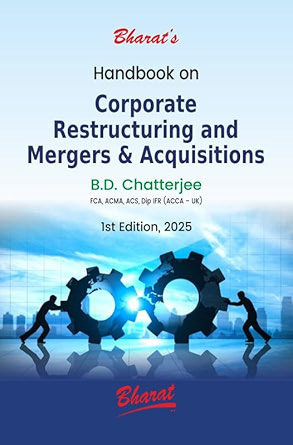Handbook on Corporate Restructuring and Mergers & Acquisitions
About the Book: conceptualized as a practical and strategic guide in navigating the multifaceted world of corporate restructuring and M&A

About the Book: conceptualized as a practical and strategic guide in navigating the multifaceted world of corporate restructuring and M&A
Handbook of Corporate Restructuring and Mergers & Acquisitions has been conceptualized as a practical and strategic guide in navigating the multifaceted world of corporate restructuring and M&A and is spread across the following sections:
Part I: Corporate Restructuring – An Overview, explains with illustrations types of corporate restructuring and offers a strategic perspective on why and how organizations restructure to remain agile and viable.
Part II: Legal Frameworkprovides a comprehensive account of the regulatory ecosystem in India, including relevant provisions from the Companies Act, Income Tax Act, Competition Act, FEMA, and applicable accounting standards. Thissection lays a strong legal foundation for professionals involved in compliance, structuring, and advisory roles.
Part III: Mergers and Acquisitions delves into the strategic drivers, execution mechanics, and forms of M&A with real life global and Indian case studies, offering a clear understanding of transactions ranging from horizontal mergers to cross-border acquisitions.
Part IV: Due Diligence explores both the sell-side and buy-side due diligence frameworks, highlighting key focus areas, red flags, and the importance of commercial, legal, financial, and operational validation.
Part V: Valuation and Risk Management, deep dives through valuation methodologies—DCF, market multiples, and strategic valuation—tailored for M&A scenarios. Parallelly, the book outlines risk identification, quantification, and mitigation strategies aligned with enterprise risk management (ERM) principles.
Part VI: Deal Structuring offers insight into financing options, negotiation strategies, regulatory clearances, and the legal architecture required to finalize M&A transactions.
Part VII: Post-Merger Integration focuses on one of the most critical yet overlooked dimensions of M&A—how to plan, execute, and manage integration to realize intended synergies and sustain business continuity. This includes change management, organizational alignment, and post-merger performance review. The final section.
Part VIII: Emerging Trends explores cutting-edge developments shaping the M&A domain—such as ESG integration into transaction decision-making and the growing influence of digital transformation, artificial intelligence, and data analytics in deal origination, diligence, and value creation.
This book is both a strategic reference and an execution manual—equally valuable to corporate executives, M&A advisors, investment bankers, legal professionals, and finance leaders. It bridges theoretical underpinnings with practical execution, offering case insights, legal checklists, valuation models, and risk dashboards that are essential to deal success in today’s fast-changing business environment. Whether managing corporate restructuring, evaluating an acquisition, or leading a post-deal integration, this handbook equips you with the tools to deliver informed, compliant, and value-driven outcomes.

